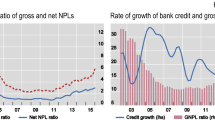Abstract
The key responsibility of the banking sector is to provide credit to consumers, corporations and small firms. In case of firms, bank credit is an essential part of financing investment activities, particularly within the European financial model. Households use debt primarily to finance consumer spending and mortgages, but for firms an external source of finance is essential to their investments, which in the long run is fundamental to the GDP growth. However, excessive leverage can also be harmful: Cecchetti et al. (2011), using OECD data, found that corporate debt above 90 per cent of GDP and household debt above 85 per cent of GDP constitute a financial burden which may hamper a country’s economic growth. In the light of the 2007–09 financial crisis, it has become particularly important to understand how banks make loans and to establish what are the factors influencing credit structure and composition.
Access this chapter
Tax calculation will be finalised at checkout
Purchases are for personal use only
Preview
Unable to display preview. Download preview PDF.
Similar content being viewed by others
References
Aisen, A., and M. Franken (2010) ‘Bank credit during the 2008 financial crisis: a cross-country comparison’, International Monetary Fund Working Paper, No. 10/47.
Beck, T. (2013) ‘Bank financing for SMEs — lessons from the literature’, National Institute Economic Review Report.
Beck, T., A. Demirguç-Kunt, M. Soledad, and M. Peria (2008a) ‘Bank financing for SMEs around the world: drivers, obstacles, business models and lending practices’, The World Bank Working Paper, No. 4785.
Beck, T., B. Büyükkarabacak, F. Rioja, and N. Valev (2008b) ‘Who gets the credit? And does it matter? Household vs. firm lending across countries’, The World Bank Working Paper, No. 4661.
Beck, T., A. Demirgüç-Kunt, M. Soledad, and M. Peria (2011) ‘Bank financing for SMEs: evidence across countries and bank ownership types’, Journal of Financial Services Research, 39(1): 35–54.
Beck, T., H. Degryse, R. De Haas, and N. Van Horen (2014) ‘When arm’s length is too far: relationship banking over the business cycle’, EBRD Working Paper, No. 169.
BEEPS (2005) Business Environment and Enterprise Performance Survey, EBRD-World Bank.
BEEPS (2008) Business Environment and Enterprise Performance Survey, EBRD-World Bank.
Bolton, P., X. Freixas, L. Gambacorta, and P.E. Mistrulli (2013) ‘Relationship and transaction lending in a crisis’, BIS Working Papers, No. 417.
Bongini, P., M.L. Di Battista, and L. Nieri (2009) ‘Relationship banking: an old solution for the present crisis?’, BANCARIA, Bancaria Editrice, 5 (May): 2–20.
Boot, A. (2000) ‘Relationship banking: what do we know?’, Journal of Financial Intermediation, 9(1): 7–25.
Cappiello, L., A. Kadareja, Ch. Kok Sørensen, and M. Protopapa (2010) ‘Do bank loans and credit standards have an effect on output? A panel approach for the euro area’, ECB Working Paper, No. 1150.
Cecchetti, S.G., M.S. Mohanty and F. Zampolli (2011) ‘The real effects of debt’, BIS Working Paper, No. 352.
De Haas, R., D. Ferreira, and A. Taci (2007) ‘What determines banks’ customer choice? Evidence from transition countries’, EBRD Working Paper, No. 104.
De Haas, R., D. Ferreira, and A. Taci (2010) ‘What determines the composition of banks’ loan portfolios? Evidence from transition countries’, Journal of Banking & Finance, 34(2): 388–98.
ECB (2004) EU Banking Structures, European Central Bank, Frankfurt.
ECB (2006) EU Banking Structures, European Central Bank, Frankfurt.
ECB (2010) EU Banking Structures, European Central Bank, Frankfurt.
Fiordelisi. F., S. Monferrà, and G. Sampagnaro (2013) ‘Relationship lending and credit quality’, available at http://ssrn.com/abstract=2210356.
Gambacorta, L., J. Yang, and K. Tsatsaronis (2014) ‘Financial structure and growth’, BIS Quarterly Review, March.
Matousek, R. (ed.) (2010) Money, Banking and Financial Markets in Central and Eastern Europe. 20 Years of Transition (Basingstoke: Palgrave Macmillan).
NIER Report (2013) ‘The credit cycle and the real economy’, The National Institute Economic Review, No. 225.
Ongena, S., J.L. Peydro, and N. van Horen (2013) ‘Shocks abroad, pain at home? Bank-firm level evidence on the international transmission of financial shocks’, DNB Working Paper, No. 385.
Popov, A. and G.E Udell (2010) ‘Cross-border banking and the international transmission of financial distress during the crisis of 2007–2008’, ECB Working Paper, No. 1203.
Editor information
Editors and Affiliations
Copyright information
© 2015 Ewa Miklaszewska and Katarzyna Mikołajczyk
About this chapter
Cite this chapter
Miklaszewska, E., Mikołajczyk, K. (2015). The Role of Loan Dynamics and Structure for CEE Economic Growth. In: Beccalli, E., Poli, F. (eds) Lending, Investments and the Financial Crisis. Palgrave Macmillan Studies in Banking and Financial Institutions. Palgrave Macmillan, London. https://doi.org/10.1057/9781137531018_4
Download citation
DOI: https://doi.org/10.1057/9781137531018_4
Publisher Name: Palgrave Macmillan, London
Print ISBN: 978-1-349-56498-9
Online ISBN: 978-1-137-53101-8
eBook Packages: Palgrave Economics & Finance CollectionEconomics and Finance (R0)




